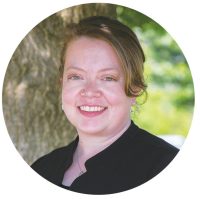Interview with Susan Miller−Manager, Office of Public Affairs, Fairfax Water, Fairfax, VA
By Michael Tinnesand October/November 2017

After graduating with a degree in biology from Bridgewater College in Virginia, Susan Miller went to work for Fairfax Water as a lab analyst doing water quality testing. She later moved to the position of chemist, where her responsibilities expanded to more complex analyses of water, including handling customer problems with their water supply. She also had a chance to work during the summer with high school students who were interested in science fair projects. ChemMatters talked to Susan about how she came to her current position and some of the issues she faces with the water supply.
How did you get started in public affairs for Fairfax Water after working as a lab analyst and chemist?
After working in the lab for 12 years, I took advantage of a tuition reimbursement program my employer offered to go back to school. I earned a Master’s of Business Administration (MBA), which prepared me to work in new areas of our organization beyond the technical realm of water quality assurance. It was a great opportunity to apply the things I learned as a chemist to other areas.
What advice would you give to students interested in pursuing a career in science?
This is a great time to pursue a career in the water-treatment industry. We are facing a shortage of workers due to the aging of our current workforce. This industry offers interesting jobs that have the potential for advancement. We do the important work of delivering safe water to our community.
Is there such a thing as 100% pure water? Is it reasonable to have our water be 100% pure?
Theoretically such a thing is possible, but it is virtually impossible to deliver ultrapure water to homes. And even if it were possible, it would be a terrible idea. Ultrapure water has a tendency to absorb minerals and salts from your body and could upset the balance of your electrolytes. It is important to know what is in our water and set safe limits for the chemicals typically found in our water.
The types of chemicals we find in our water vary by region and locale, but in the United States every water utility is required by the federal government to publish an annual Consumer Confidence Report (CCR), or a water quality report. You can find what is in your community’s drinking water by going online to your local water utility, or you can call and ask for a print copy of this report.
What is the biggest problem with our current water supply nationwide?
I have to say it is the aging infrastructure we use to deliver our water to homes and businesses. Water pipes and mains are frequently more than 100 years old and need to be replaced. Some of these old pipes contain lead or other contaminants. Replacing them is very expensive and is often postponed in the face of other priorities.
Is it ever safe to drink water from a lake or river?
This is risky. Even if a lake looks pristine and may be in the wilderness, it is impossible to know what contaminants might be in the water. There could be fecal contamination from humans or animals, or there could be toxic minerals that leech from the natural soils in the area. It is always best to carry a portable water purification system, or to boil water before you drink it.
Bottled water is as much as 1000 times more expensive as tap water. Is drinking bottled water a good idea?
The big advantage of drinking bottled water is convenience. Sometimes it is easiest to grab a bottle of water from a local market to stay hydrated. Otherwise, there is typically no difference in quality. Tap water is regulated by the Environmental Protection Agency (EPA), while bottled water is regulated by the Food and Drug Administration (FDA). So they are both safe, it is just a matter of cost versus convenience.
Some reports say less than 5% of treated water is used for drinking and cooking. Is it reasonable to treat all of our water to safe drinking standards when much of it isn’t used that way?
The problem is that we must treat all water as though it will be consumed. There is no easy way to provide one purity of water for consumption and another for “gray water” use such as washing dishes or watering the lawn. Plus, it is hard to say how water will be used. Perhaps a person might rinse their mouth while taking a shower, so they want treated water. And you wouldn’t want to wash your hands with gray water at a hospital. That said, there are some new buildings that have installed systems to provide gray water exclusively for watering lawns and other safe gray water uses.
Also in this Issue...

Composting is a way to harvest crops with natural fertilizer and reduce our contribution to greenhouse gases—a win-win!

